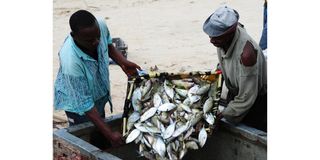Tanzania loses Sh15 billion in five years due to illegal fishing

Fishermen on Mafia Island empty their days catch onto a cooler box that will be shipped to Dar es Salaam in Tanzania for sale and consumption.Photo | Courtesy of WWF
What you need to know:
- Dar es Salaam performed better than other regions in fisheries resources management due to its better infrastructure and geographical setup
Dar es Salaam. The government has lost about Sh15.162 billion in potential revenue during the past five years due to fishermen’s use of unregistered and unlicensed fishing vessels, the Controller and Auditor General (CAG) says.
In his latest performance audit report on the management of fisheries resources in Tanzania, the CAG, Mr Charles Kichere, says 72.99 percent of operating fishing vessels in the country are unregistered and unlicensed.
With the Indian Ocean, Lakes Victoria, Tanganyika and Nyasa, as well as several rivers and dams at its disposal, Tanzania is one of Africa’s top 10 countries in terms of total capture fisheries production.
The country captures an average of 395,006 tonnes per year, and the volume has been growing at an average annual rate of 1.5 percent.
Fishing plays an important role in food security and socio-economic well-being.
But that notwithstanding, the CAG says that for the past five years (from 2018 to 2023), a total of 28,615 vessels have been operating fishing activities in various water bodies in the country.
Out of the total, however, 20,885 have not been registered or licenced.
“The presence of both unregistered and unlicenced vessels has led to a potential cumulative loss of Sh15.162 billion, which would have been generated through the fisher's registration licence fee and the Tanzania Shipping Agencies Corporation (Tasac) fee,” said the CAG, Mr Charles Kichere, in the report, which was released this week.
Due to that, the audit noted the existence of illegal fishing practices in terms of both fishing gear and methods in the audited water bodies at different levels. The use of illegal fishing gear is much more prevalent in Lake Victoria, which has approximately 60-gill nets at each landing site.
Dar es Salaam and Lindi experienced a potential annual loss below Sh500 million, with less than 30 percent of vessels being unregistered and unlicensed.
“Dar es Salaam performed better than other regions due to its better infrastructure and geographical setup. The region operates fishing activities in a centralised manner, which makes it easy to regulate.”
Mr Kichere said that inadequate management of the maximum allowable catch regime is an important tool in approximating the abundance of fish stocks within a system to determine the optimal harvesting levels that ensure maximal economic benefits without destroying the fishery sector.
“It was noted that neither the ministry of Livestock and Fisheries (MLF) nor the President’s Office, Regional Administration, and Local Government (PO RALG) developed or implemented measures on the maximum allowable catch limits on fish stock to be taken from their water bodies. This is attributed partly to a lack of guidance from the Tanzania Fisheries Research Institute (Tafiri), which provides scientific surveys to determine the availability of fish stock in our water bodies,” he noted.
He recommended that the MLF ensure access to fisheries resources is managed and controlled through an improved system for registration and licencing by offering licences to all fishing crafts, fishing vessels, and fishers in the water bodies as per the existing fisheries legislation.
Also, he proposed the creation of a digital and effective mechanism that will ensure the smooth collection of real-time data on fish caught and the distribution of fishing efforts in the water bodies.
As for the PO RALG, he said the system for registration and licencing of all fishing crafts, fishing vessels, and fishers in the water bodies enhances total control in the fishing sector.
As well as enforce and adhere to the obligation of closing fishing activities during defined close seasons to allow for fish breeding and improve the sustainability of fisheries stock.





